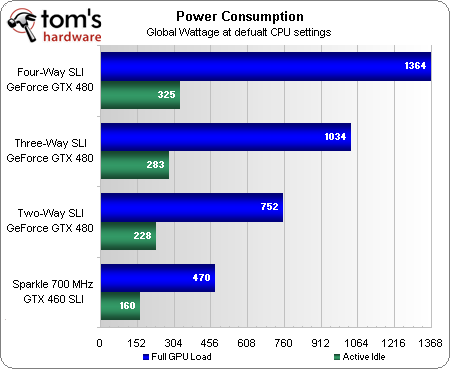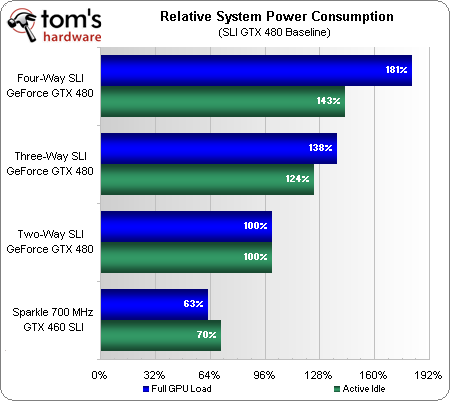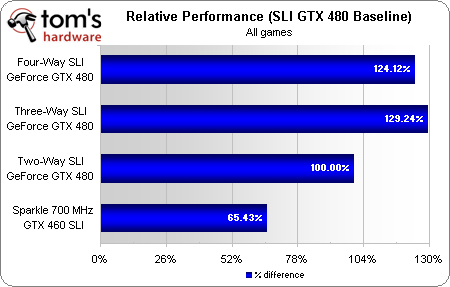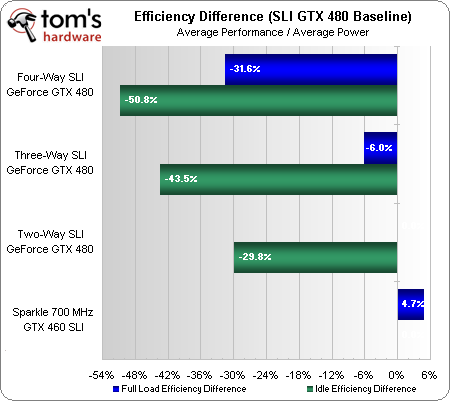Gaming Across Three Screens: GTX 460, GTX 480, And Quad-SLI
Display spanning is quickly becoming the high-mark for serious gaming machines of all budgets, with more powerful cards allowing higher resolutions. Yet, as panel resolutions higher than 1080p become harder to find, do we really need more than two cards?
Energy And Efficiency
Against our own advice, we used a 1000 W power supply in today’s four-way SLI tests. How much power did we really need?
Manufacture-specified TDP aside, it appears that our power supply actually needed 282 W per GeForce GTX 480 graphics card. Yet, pushing our power supply beyond its rated limit caused the four-way configuration to pull 1364 W (rather than 1316 W), dropping our power supply’s efficiency from its rated 89% to 85%. That means the maximum continuous output power we demanded of OCZ’s Z1000 power unit was 1164 W, a full 16% beyond its rating. Bravo OCZ!
Putting power consumption on a percent scale allows us to more easily calculate relative efficiency. We based our comparison on the GTX 480 SLI configuration, where GTX 460 SLI represents the lower-energy alternative.
Putting aside special circumstances where the four-way SLI configuration took a commanding lead, its overall performance looks worse than that of three-way SLI.
Efficiency is a comparison of work done to power used, calculated by dividing the above two charts. This would have normally resulted in a 100% score for the baseline configuration.
Because there really is no such thing as 100% efficiency in the computer industry, we subtracted “1” from the results in the above chart to show only the efficiency differences. As the above chart shows, a third card uses enough energy to lose 6% in efficiency, in spite of its 29% performance gain.
Get Tom's Hardware's best news and in-depth reviews, straight to your inbox.
-
duk3 Sapphire’s 700 MHz cardsReply
They look like sparkle cards to me.
EDIT: Now fixed, I thought it was funny that sapphire made gtx460s -
damasvara BluescreendeathGTX480 Quad SLI - Yes, it can play Crysis. Maxed out at 5760x1080 too!It's so hot, it can also make steak BBQ for you! Watch out for anti-terrorist bust over the Fermi thermal suspicion though... :lol:Reply
-
Now i am curious to see a performance difference between tri and quad sli in triple 30" 2500x1600 monitors (7500x1600 resolution).Reply
-
hurt74 @duk3Reply
Isnt it nice to know that sappire tech now makes NVIDIA cards because the last time i know they are an ATI exclusive. Good job toms -
vicskyline96 cool, so the drivers support quad 480s now? i wonder if they support tri SLI 200 series cards, i'm sure theres still people out there who want to try this on their older generation cardsReply -
joytech22 Wow, that power usage is insane! it's hard to believe that these 480's use so much power.. you'd need like a thermaltake toughpower 1500w or something, or maybe 2 PSU's!Reply -
andrern2000 4 GTX 480s are a gig. But how much price is it is totally another matter. I prefer to 2-way SLI GTX 480.Reply -
vicskyline96 cool, so the drivers support quad 480s now? i wonder if they support tri SLI 200 series cards, i'm sure theres still people out there who want to try this on their older generation cardsReply




